Bulletin – June 2016 Australian Economy Household Wealth in Australia: Evidence from the 2014 HILDA Survey
- Download the article 344KB
Abstract
This article uses data from the Household, Income and Labour Dynamics in Australia (HILDA) Survey to assess how the distribution of wealth changed for Australian households between 2010 and 2014. Average household wealth increased modestly over that period, driven mainly by growth in the value of financial assets, most notably superannuation. The growth of housing wealth was slow in comparison, particularly in Queensland and Western Australia. While most of the changes in wealth were broadly based across households, wealth increased more rapidly for those residing in New South Wales and for retired households with large holdings of superannuation and equity assets.
Introduction
The HILDA Survey has been conducted annually since 2001. Every four years the survey includes a wealth module, which asks respondents detailed questions about their holdings of assets and liabilities. The results of the 2014 wealth module were released recently. As the survey is designed to track the same respondents each period, it provides an insight into how particular households' assets and liabilities have evolved over time.[1]
Previous Bulletin articles have used earlier releases of the HILDA Survey to describe the distribution of household assets and liabilities across a number of dimensions, including by income, wealth, age, employment and homeownership status.[2] As the general distribution of household wealth (i.e. total assets minus total debts) across these categories is broadly the same in 2014 as it was in 2010, this article focuses on how the distribution of housing assets (including investment properties), non-housing assets (predominately superannuation) and household debt have changed between 2010 and 2014.
The HILDA Survey data suggest that the average Australian household had total wealth of around $740,000 in 2014. Measures of real (inflation adjusted) wealth per household from the HILDA Survey grew a little less over the decade to 2014 than measures based on household-level data from the Australian Bureau of Statistics (ABS) Survey of Income and Housing (SIH) and distributional wealth indicators from the ABS that are consistent with aggregate data from the Australian System of National Accounts (ASNA) (Graph 1).[3], [4] However, the value of assets grew faster than the stock of new debt across all three measures.
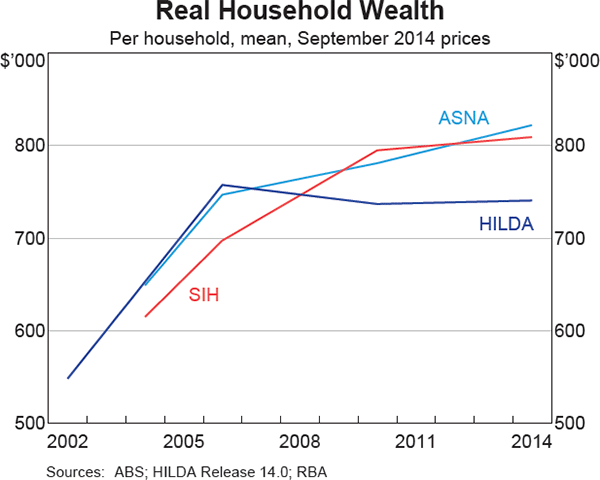
The divergences in the three measures of average wealth over the past decade reflect a number of differences in measurement and coverage.[5] Part of this is likely to be due to the difficulty all household surveys encounter with surveying very wealthy households, and the challenges in scaling survey data to reflect aggregate demographic characteristics.
Looking at the cross-sectional distribution of household wealth, older and higher-income households tend to have higher levels of wealth (Graph 2). A comparison of wealth in the HILDA Survey with the distributional measures available from the ABS surveys suggests that they are broadly similar, although the level of wealth across different cross-sections is generally estimated to be a little lower in the HILDA Survey, particularly for high-income and very wealthy households.
The distribution by wealth quintile shows that wealth is very unequally distributed: the average level of wealth for households in the top wealth quintile is over four times that of households in the middle quintile. The age profile shows how households accumulate wealth in the lead-up to retirement. Given that the distributional patterns of household wealth are consistent across the different data sources, the rest of this article focuses on the data from the HILDA Survey.
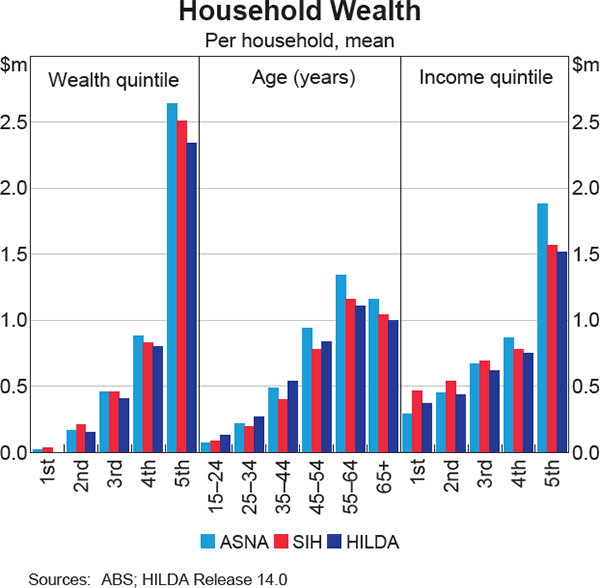
Household Wealth
Overall, almost 60 per cent of households in the HILDA Survey had more real wealth in 2014 than was the case in 2010.[6] Households with the lowest levels of wealth in 2010 saw the most growth of wealth over the four years to 2014 (Graph 3). This partly reflects the fact that low-wealth households are generally young and are just starting to build wealth. Correspondingly, younger households saw growth of wealth than older households.[7] Higher-income households, with the most wealth-building capacity, increased wealth at a faster rate than low-income households.
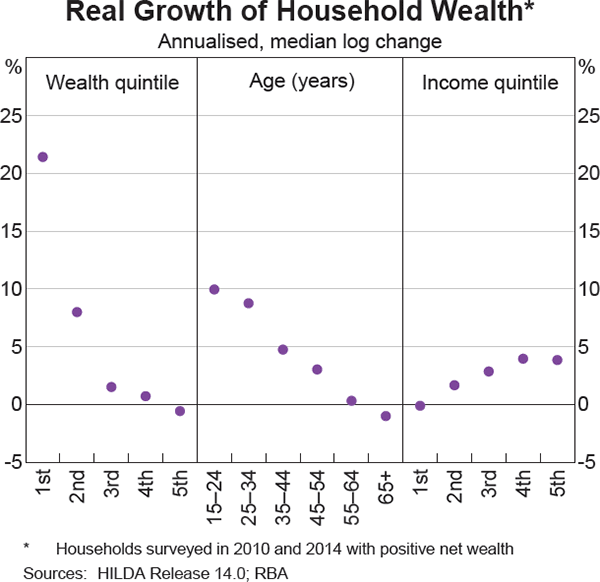
Looking at the aggregate change in wealth for Australian households implied by the HILDA Survey, most of the increase in wealth over the 2010–14 period came from growth in the value of non-housing assets, which are predominantly financial assets such as superannuation, equities and deposits (Graph 4). The real value of households' housing assets increased slightly over the period and households taken together increased their level of average debt only marginally. This contrasts with growth in household wealth over the 2002–06 and 2006–10 periods, which was primarily driven by growth in the value of housing assets.
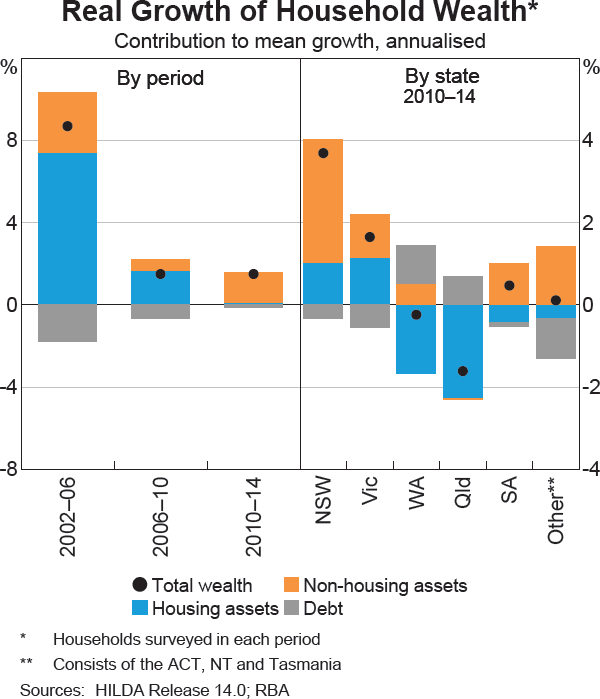
Households across the different states and territories also fared quite differently between 2010 and 2014. Households in New South Wales and Victoria saw the largest increase in wealth, with growth in both housing and non-housing assets, while households in Queensland and Western Australia saw the biggest decrease in wealth, on average, mainly owing to a fall in the value of housing assets. The other states and territories generally saw relatively little growth in wealth over the period. The outcomes for households in Queensland and Western Australia are likely to have been influenced by the decline in commodity prices and the mining investment boom following the peak, which occurred between 2010 and 2014.
The following sections consider in more detail how housing assets, debt and non-housing assets developed for different households over the 2010–14 period.
Housing Assets
Housing is the largest asset class on Australian households' balance sheets, accounting for around 60 per cent of total assets. Over any given period, growth in housing assets can be due to a change in housing prices or a change in the stock of housing held by Australian households. As discussed above, households in the HILDA Survey reported weak annual average growth in the real value of their housing assets between 2010 and 2014, although growth in housing varied substantially across different states and territories. Looking more closely across the states reveals large differences in the mean and median values of housing assets (Graph 5).[8] Similar state-level patterns are also observed in the SIH data. According to the HILDA Survey almost all of the growth in housing assets from 2010 to 2014 was due to changes in the price of housing assets, rather than changes in the quantity of housing assets held by households. This is consistent with aggregate ABS statistics over the period.
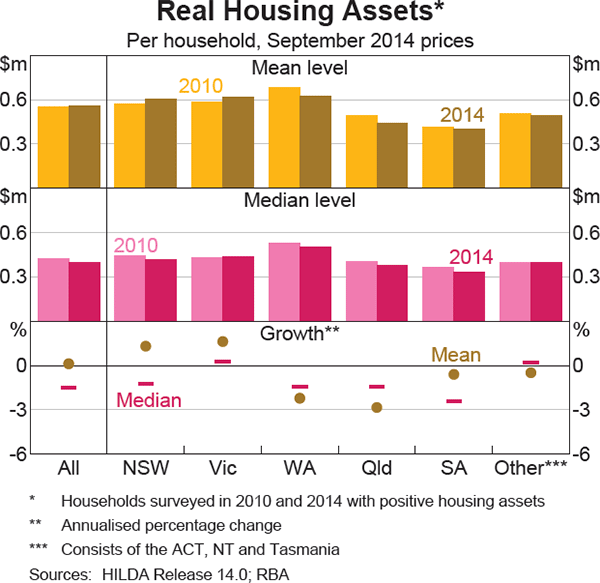
New South Wales and Victoria were the only states where households reported growth in the real average value of housing assets between 2010 and 2014, while Queensland and Western Australia reported that real housing asset values declined. This contrasts to the period of strong growth reported for Western Australia and Queensland in the HILDA Survey from 2002 to 2006.[9] However, even with the decline in housing asset values over recent years, households in Western Australia still reported the highest value of housing assets in 2014.
The fact that median housing asset values decreased in NSW, while mean housing asset values grew, suggests that households with a larger value of housing assets in this state experienced strong growth in housing assets over the period. This result aligns with the strong demand for higher-priced detached dwellings in Sydney relative to demand for dwellings in other areas of New South Wales.
State-level differences in the growth of real housing asset values are consistent with differences in state housing market conditions over the period. In New South Wales and Victoria, stronger average housing price growth reported by the ABS between 2011 and 2014 has been driven particularly by investor demand for housing. In Queensland and Western Australia, demand for housing is likely to have been affected by the peak of the mining investment and commodity prices during the 2010–14 period and households having lowered their expectations for growth in population and household incomes.
Despite this, housing ownership rates in the HILDA Survey remained fairly stable across the states between 2010 and 2014. Overall, around 66 per cent of all households in Australia own their primary place of residence and 20 per cent of households own other property (including investment property). Similar to previous surveys, home ownership typically increases with income, wealth and age (until retirement), and ownership of other property was highest for households where the household head is aged 45 to 64 years.
The data also allow analysis on which households entered the housing market or increased their housing asset holdings between 2010 and 2014. This shows that the share of households that either became home owners for the first time or upgraded their main residence decreased relative to the 2006–10 period (Graph 6). This was particularly apparent for households aged 25 to 44 years. Households in this age range were more likely to have increased their holdings of other property assets, while those aged 15 to 24 years were less likely to invest in other property than they were between 2006 and 2010 (Graph 6).
Although households aged between 55 and 64 years were also less likely to purchase housing assets over this period than over the previous four years, they remained the age group with the highest rates of property ownership and were the largest holders of housing assets. Households in New South Wales and Victoria were slightly more likely to increase their holdings of other property than was the case from 2006 to 2010.
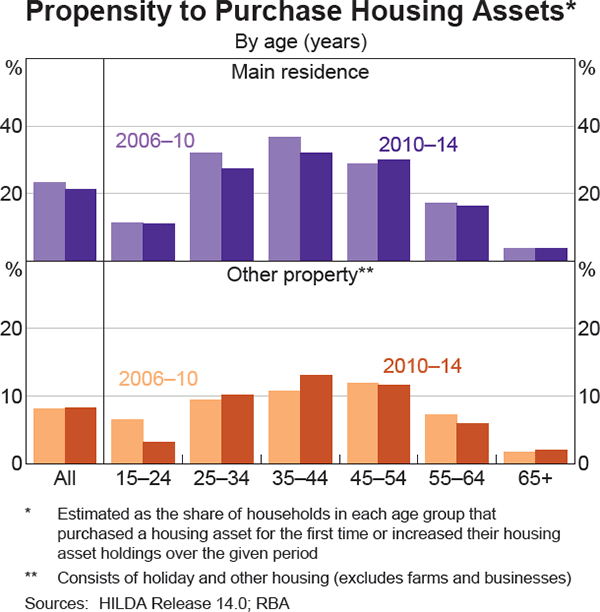
Most of these purchases would have been predominantly funded by mortgages, so the distribution of households purchasing housing assets over the period is likely to have influenced the distribution of household debt.
Household Debt
The distribution of debt in Australia is highly skewed. High-income households hold the majority of debt. The top income quintile held almost 50 per cent of the stock of household debt in 2014. Almost a third of households held no debt, with the majority of these being retired households.
Over the four years to 2014, about 40 per cent of households increased their levels of nominal debt, while a similar share of households reduced their holdings of debt (Graph 7). The remaining quarter of households maintained the same, mostly negligible, amount of debt over the period.
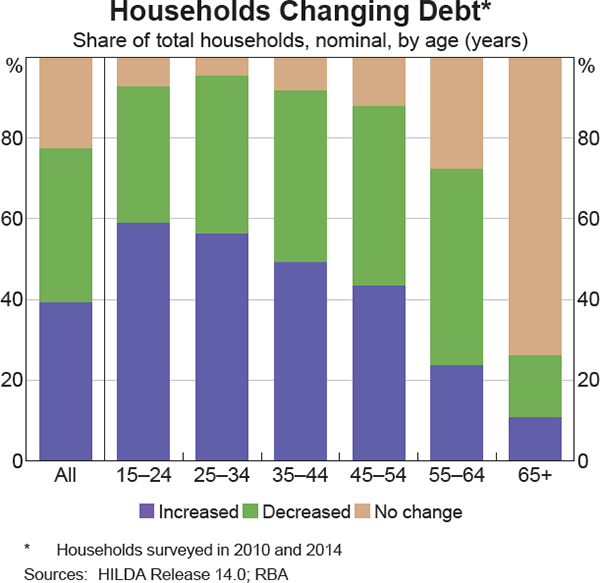
As was the case in previous surveys, younger households were more likely to have increased their debt levels than older households. Almost 60 per cent of households aged between 15 and 24 years increased their debt from 2010 to 2014, compared with 6 per cent of those aged 75 years or more. This was likely to have been due to life-cycle effects – young households take on debt to fund their education and purchase property, before paying down the debt over their working lives.
Property debt accounted for a little over 80 per cent of the stock of debt held by households in 2014. Average debt increased modestly from 2010 to 2014, by a little more than 2 per cent per year (Graph 8). Households in Queensland reduced their average level of property debt over the period, while households in Western Australia saw a slight increase and the other states and territories saw much stronger growth in debt. Following households through time shows that a similar proportion of households in each state increased their level of nominal debt between 2010 and 2014. This suggests that, on average, households in New South Wales, Victoria and South Australia took on more debt, or paid off less debt, than households in other states over the period.
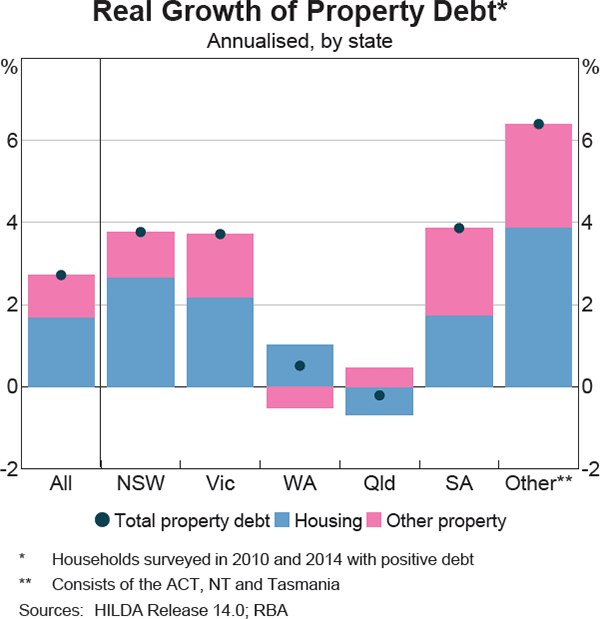
Non-housing Assets
According to the HILDA Survey, the average value of non-housing assets increased by around 3 per cent per annum in real terms from 2010 to 2014. ABS data which are consistent with the national accounts suggest that this growth was around 4 per cent. Both data sources indicate that non-housing asset growth picked up relative to the 2006–10 period, but remained lower than the growth seen between 2002 and 2006.
Tracking the same households over time indicates that the pick-up in growth for non-housing assets was partly due to the recovery of asset values following the 2008–09 period, particularly for assets such as equities and superannuation. Of the 40 per cent of households who reported a decrease in value of these assets from 2006 to 2010, roughly two-thirds reported an increase in value from 2010 to 2014. Around 40 per cent of these households reported an increase in value to a level that exceeded the initial real value of these assets in 2006.
The mean value of real non-housing assets increased from around $320,000 in 2010 to almost $400,000 in 2014 (Graph 9). Overall, non-housing assets accounted for 43 per cent of total household assets in 2014, up from 39 per cent in 2010.
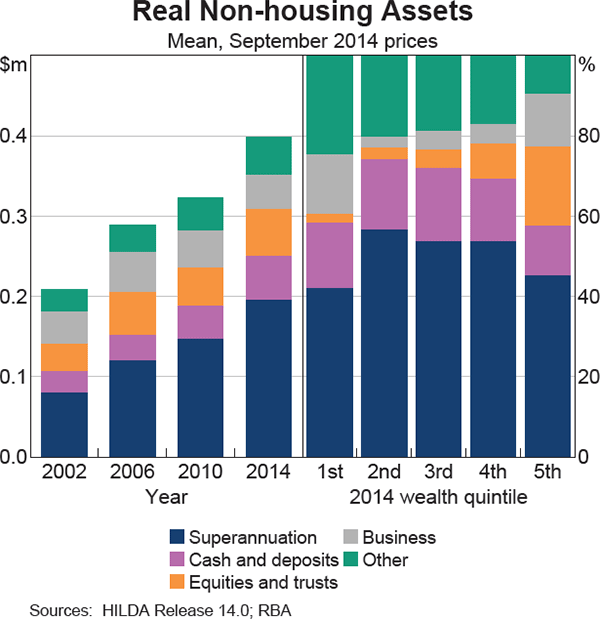
Superannuation accounted for around half of the value of non-housing assets in 2014 and was the second largest asset class in Australian households' balance sheets, after housing. Deposits and direct equity holdings accounted for 14 and 15 per cent of non-housing assets, respectively. Business assets accounted for 11 per cent of non-housing assets and the remainder comprised of other assets such as life insurance and durable goods (including motor vehicles and collectibles). Wealthier households held a higher-than-average share of assets in the form of direct equity holdings and business assets, while households with lower net wealth held more in cash and deposits, superannuation and durable goods (Graph 9).
Most of the increase in non-housing assets between 2010 and 2014 came from growth in superannuation assets. The mean superannuation balance grew by around 4 per cent per annum in real terms for all households over the period to $250,000 in 2014 (Graph 10).[10] The share of households with superannuation holdings also increased from 80 to 84 per cent.
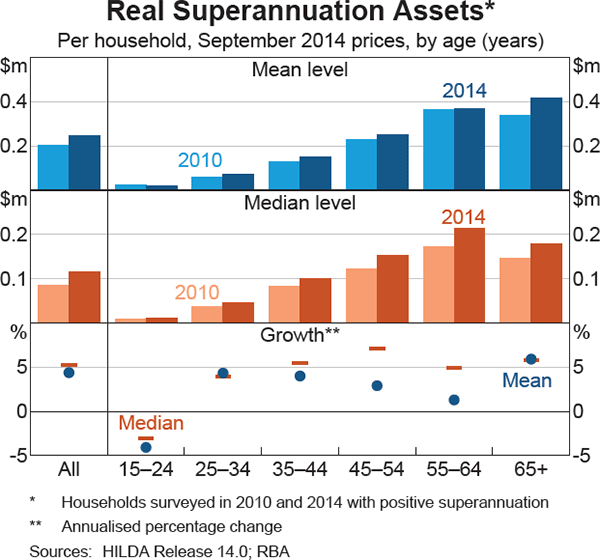
Annual mean growth in superannuation was highest for households over the age of 65 years, which is a pattern that is also seen in the ABS data that are consistent with the national accounts. The fact that retired households' superannuation assets grew, despite these households typically running down superannuation balances, suggests that valuation effects have played a role in the growth of superannuation assets for this age group.
The noticeably stronger growth in median superannuation assets relative to the mean for households aged 45 to 64 years suggests that the ‘typical’ (or median) household in these age groups are building up superannuation assets faster in the lead-up to retirement than the households in the same age group with the largest balances of superannuation (Graph 10).
Aggregate data from the ABS indicate that real growth in superannuation assets between 2010 and 2014 was due to both positive valuation effects and an increase in new inflows into superannuation assets (i.e. stock effects). Positive valuation effects can be explained in part by stronger average returns of superannuation funds over the 2010–14 period that were helped by the recovery in global equity markets and by a large depreciation of the Australian dollar, which raised the value of investments in overseas assets held by superannuation funds.
New inflows into superannuation assets between 2010 and 2014 were likely to have been boosted by the increase in the minimum employer contribution rate from 9 to 9¼ per cent in July 2013 and by Australian households making fewer, but larger-sized voluntary personal contributions into their superannuation funds. While a lower share of households in the HILDA Survey reported making either a lump sum or salary-sacrificed voluntary contributions in 2014, the average annual value of voluntary contributions into superannuation increased to around $25,000, compared to $19,000 in 2010.
A closer look at retired households suggests that growth in superannuation assets for this cohort has been lifted by the growth in the value of assets held by self-funded retirees, who account for around 25 per cent of retired households over the age of 55 years. Self-funded retirees are households that do not rely on government aged pensions or allowances to support their retirement.[11] Instead, these households typically hold a larger share of assets in superannuation and equities than other retired households, and fund retirement using income generated from these assets. Between 2010 and 2014, superannuation grew at around 9 per cent per annum in real terms for self-funded retirees compared to 4 per cent per annum for other retired households.
Conclusion
Household-level data from the HILDA Survey can be used to examine how wealth changes over time for households in different age and income groups, and in different regions of Australia. Real household wealth increased modestly between 2010 and 2014, although growth remained slower than the pace seen in the first half of the 2000s. The main driver of growth in household wealth over that period was an increase in the value of financial assets, mostly superannuation assets. Weaker growth in housing wealth, with declines in Queensland and Western Australia, contributed to the slower growth in total wealth from 2010–14. Overall, wealth increased most for households in New South Wales and for wealthier, retired households with a larger share of wealth in superannuation and equity assets.
Footnotes
Paul Ryan is from Economic Analysis Department and Tahlee Stone is from Economic Research Department. [*]
Respondents can drop out of the HILDA Survey due to death, a move overseas, loss of contact with the survey, or a refusal to remain in the survey; the newly formed households created by the split of an existing household remain in the survey. For more information on the HILDA Survey, see <http://www.melbourneinstitute.com/hilda>. [1]
See Kohler, Connolly and Smith (2004), Bloxham and Betts (2009) and Finlay (2012). Additional data, including from previous HILDA releases, are available from Statistical Tables E3–E7 on the Reserve Bank website <http://www.rba.gov.au/statistics/tables/>. [2]
The Consumer Price Index is used to adjust wealth data for the change in purchasing power between the periods due to inflation. All real values are reported in September quarter 2014 dollars. [3]
The ASNA indicator will be referred to as the ‘national accounts consistent distributional measure’ as it integrates household-level survey data from the SIH with macro-level data from the national accounts. For more information on the national accounts consistent distributional measures constructed by the ABS, see (ABS 2013) for more details. [4]
For more information on the differences between HILDA and the aggregate national accounts, see Headey, Warren and Wooden (2008). [5]
This number includes households who are net debtors, while estimates shown in Graph 3 only include households with positive net wealth in 2010 and 2014. [6]
This analysis does not control for interactions between age and wealth which might be important. [7]
Both mean and median statistics are reported in Graph 5 to provide a more detailed picture of how housing assets changed over the survey period. The mean describes an average value, while the median is more representative of a ‘typical’ household since it describes the household in the middle of the distribution and is less sensitive to extremely low and high values. [8]
During this earlier period, the median real value of non-financial assets (predominately housing) assets grew by 20 and 15 per cent a year for Queensland and Western Australia, respectively. See Bloxham and Betts (2009). [9]
See footnote 8 for an explanation of the mean and median statistics used in Graph 10. [10]
The ABS defines ‘self-funded retiree households’ as households whose principal source of income comes from investment or superannuation income, and whose household reference person is not in the labour force (retired) and at least 55 years of age. [11]
References
ABS (Australian Bureau of Statistics) (2013), ‘Information Paper: Australian National Accounts, Distribution of Household Income, Consumption and Wealth 2009–2010’, Cat No 5204.0.55.009, Canberra.
Bloxham P and T Betts (2009), ‘The Composition and Distribution of Household Wealth in Australia’, RBA Bulletin, April, pp 5–23.
Finlay R (2012), ‘The Distribution of Household Wealth in Australia: Evidence from the 2010 HILDA Survey’, RBA Bulletin, March, pp 19–27.
Headey B, D Warren and M Wooden (2008), ‘The Structure and Distribution of Household Wealth in Australia: Cohort Differences and Retirement Issues’, Social Policy Research Paper, No. 33. Available at <https://www.dss.gov.au/sites/default/files/documents/05_2012/sprp33.pdf>.
Kohler M, E Connolly and K Smith (2004), ‘The Composition and Distribution of Household Assets and Liabilities: Evidence from the 2002 HILDA Survey’, RBA Bulletin, April, pp 1–11.